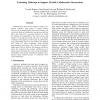Free Online Productivity Tools
i2Speak
i2Symbol
i2OCR
iTex2Img
iWeb2Print
iWeb2Shot
i2Type
iPdf2Split
iPdf2Merge
i2Bopomofo
i2Arabic
i2Style
i2Image
i2PDF
iLatex2Rtf
Sci2ools
TABLETOP
2006
IEEE
2006
IEEE
Extending Tabletops to Support Flexible Collaborative Interactions
Tabletops have been used to support a range of colocated activities, from games to image sorting. However, their limited display space and resolution can restrict the kinds of collaborative interactions that take place. Our research is concerned with how to extend the tabletop by integrating it with other spaces and artifacts in the physical world. Our goal is to design workspaces that support a wider range of collaborative tasks, determining which are well suited to the tabletop and which are better performed using physical representations and spaces. We describe a physicaldigital space that we built for this purpose and then a study that compared how groups collaborate on a design task when using this versus solely the tabletop. The findings showed that extending the tabletop into a physical space enabled groups to collaborate more easily and flexibly.
| Added | 12 Jun 2010 |
| Updated | 12 Jun 2010 |
| Type | Conference |
| Year | 2006 |
| Where | TABLETOP |
| Authors | Yvonne Rogers, Youn-Kyung Lim, William R. Hazlewood |
Comments (0)

